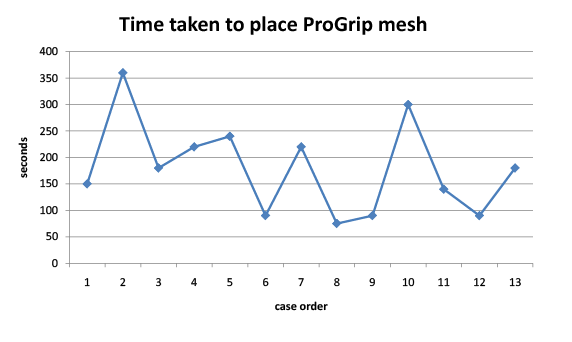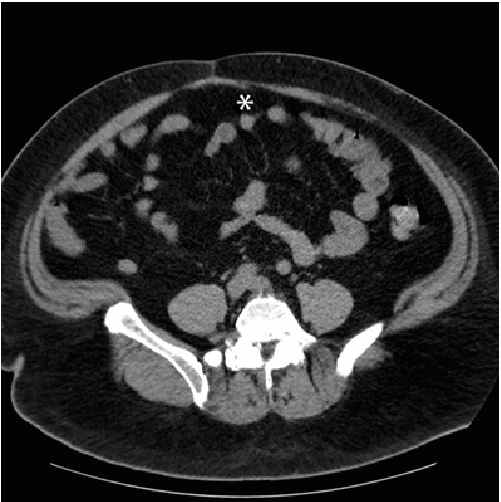
Graph 1: Time taken to place ParietexProGrip mesh (Covidien, Australia).


Arkadiusz Peter Wysocki*
Institution, Logan Hospital, Corner Armstrong and Loganlea Roads, Meadowbrook, Queensland 4131, Australia*Corresponding author: A. Peter Wysocki, Logan Hospital, Corner Armstrong and Loganlea Roads, Meadowbrook, Queensland 4131, Australia, Tel: +61 7 3299 8899; E-mail: arek_p@ecn.net.au
Introduction: Mesh repair is indicated for medium sized umbilical hernias (larger than 2 – 4 cm). Preperitoneal placement of self gripping mesh would be expected to be difficult due to its self gripping property and the small working space.
Method: The author evaluated the time taken to place CovidienParietexProGrip mesh in the preperitoneal plane during adult medium sized umbilical hernia repair.
Results: 13 primary umbilical hernias were repaired. Defects ranged between 3 cm and 4 cm. Median mesh diameter was 7 cm. Median time taken to place the mesh was 180 seconds. There have been no recurrences or surgical site complications.
Conclusion: With good outcomes, a short learning curve and easy placement, ParietexProGrip mesh is well suited to preperitoneal repair of adult medium sized primary umbilical hernias.
Umbilical hernia; Repair; Mesh
While exact epidemiological data is lacking, around a quarter of the adult population will have a clinical umbilical hernia. Around 10% of umbilical hernias are repaired [1]. The European Hernia Society classifies umbilical hernias smaller than 2cm as small and those larger than 4cm as large [2]. In one large study, adult umbilical hernias smaller than 3 cm repaired primarily had only a 6% recurrence rate at almost 6 years follow up [3]. Routine prosthetic repair is probably indicated for defects larger than 3 cm [1].
ParietexProGrip mesh (Covidien, Australia) is typically used for open inguinal hernioplasty [4]. It has also been used as an onlay mesh during incisional hernia repair [5]. The author has routinely used ProGrip mesh in the preperitoneal plane as part of elective medium sized adult umbilical hernia repair since June 2011. ProGrip is composed of absorbable polylactic acid hooks on one surface of a lightweight monofilament polyester mesh. The hooks provide Velcro (Velcro Industries, Curaçao) type adhesion to both the mesh itself and soft tissue. This self fixation would be expected to make the mesh difficult to work with in a small space. This study was designed to document the time taken to place a flat ParietexProGrip mesh in the preperitoneal plane during medium sized primary elective adult umbilical hernia repair.
Fit patients with a symptomatic umbilical hernia are offered elective repair when seen in clinic. All defects smaller than 2 cm at time of surgery are repaired primarily. Until June 2011 the author repaired all defects larger than 2 cm with preperitoneal PROLENE mesh (Ethicon, Australia) secured with transfascial PROLENE sutures (Ethicon, Australia). ParietexProGrip mesh (Covidien, Australia) became the author’s choice of mesh from June 2011 for all defects larger than 2 cm. The period of this study is from June 2011 to October 2014.
All mesh repairs were elective day case procedures under General Anaesthesia with routine Local Anaesthetic infiltration. Intravenous prophylactic antibiotics were routinely administered. Following a routine surgical approach, the defect was exposed and preperitoneal fat reduced. The preperitoneal plane was dissected using scissor or cut diathermy dissection for at least 2 cm on all sides of the defect. Peritoneal defects were closed with an absorbable suture. The cavity was irrigated. Unsecured ParietexProGrip mesh (Covidien, Australia) was placed in the preperitoneal plane. The hooks were placed facing up to the posterior rectus sheath. Drains were not used. The defect was closed horizontally over the top of the mesh with a nonabsorbable suture. Hydrodissection and enlargement of the defect were not performed.
The medical record for all 13 patients was reviewed to determine whether there were any representations to the Emergency department or other medical or surgical services or clinics with a complication or recurrence.
Over almost 3 and half years, 13 primary umbilical hernias were repaired by the author using ParietexProGrip mesh (Covidien, Australia) at Logan public Hospital in Queensland, Australia. During this time another 51 primary umbilical hernia repairs were performed (mean size of defect 1.7 cm) – these patients were excluded from this study. Defects ranged between 3 cm and 4 cm with four patients having two peri umbilical defects. Mesh diameter varied from 6 cm to 9 cm (median 7 cm). Time taken to place the mesh ranged from 75 seconds to 360 seconds (median 180 seconds) as illustrated in (Graph 1).

Graph 1: Time taken to place ParietexProGrip mesh (Covidien, Australia).
Follow up data was available for only 6 patients (range 11 – 976 days). There have been no surgical site complications or recurrences. One patient presented with renal colic three years post operatively – the Computed Tomography scan (Figure 1) shows flat mesh which has not migrated.

Figure 1: Abdominal Computed Tomography scan showing flat preperitoneal mesh (* asterisk)
This study demonstrates placing a self gripping mesh in the preperitoneal plane is not difficult or prolonged. By eliminating dissection of the anterior abdominal wall ventral to the defect, this technique may reduce the rate of seroma formation and Surgical Site infection. Prior to adopting ProGrip, the author would dissect out the prepritoneal pocket and then mobilise the fat off the anterior rectus sheath (this took approximately 2 minutes; unpublished data) to allow transfascial nonabsorbable suture mesh fixation (9 minutes; unpublished data). However, self fixation of ProGripmeans time and periumblical perforators are saved as this plane does not need to be opened as suture fixation is not necessary.
Development of adult umbilical hernias has been associated with obesity, multiparity, malignancy and ascites [6]. The ideal method of repairing umbilical hernias continues to be elusive. A recent meta analysis of three small randomised controlled studies concluded the use of mesh in repairing umbilical defects smaller than 4 cm is associated with one tenth the recurrence rate compared to primary repair [7]. Others have shown that primary repair of medium sized umbilical hernias is safe with only a 4% rate of recurrence [6]. Other authors have suggested the use of mesh may mask poor surgical technique [8]. The potential for enterotomy tarnishes the laparoscopic approach [9].
Self fixation of ProGrip also results in mesh self adherence which impairs handling and may be anticipated as being difficult. However, with good retraction and handling the mesh with two nontoothed forceps, this step takes approximately three minutes. Placing ProGrip during laparoscopic inguinal hernia repair has a learning curve of about 10 operations [10] and is probably shorter for umbilical hernias.
Using CovidienParietexProGripmesh to repair adult primary medium sized umbilical hernias is feasible, takes a short amount of time but requires further study.
APW declares no conflict of interest. The paper is not based on a previous communication to a society or meeting.
Contribution: the author is responsible for the entire study. The study has not been financially supported by Covidien
None
Download Provisional PDF Here
Aritcle Type: Research Article
Citation: Wysocki PA (2015) Quick Repair of Medium Sized Umbilical Hernias with a Self Gripping Preperitoneal Mesh. J Surg Open Access 1(2): doi http://dx.doi.org/10.16966/2470-0991.108
Copyright:© 2015 Wysocki PA. This is an open-access article distributed under the terms of the Creative Commons Attribution License, which permits unrestricted use, distribution, and reproduction in any medium, provided the original author and source are credited.
Publication history:
All Sci Forschen Journals are Open Access